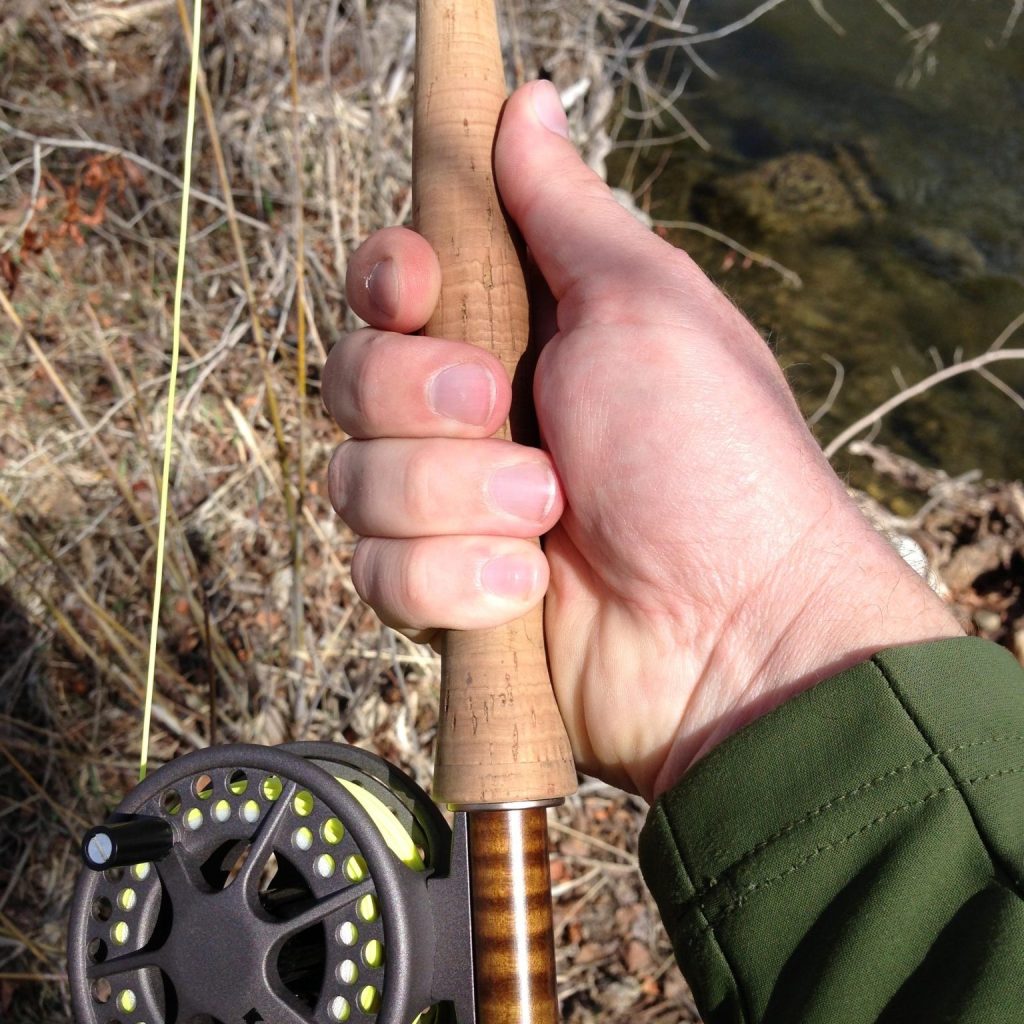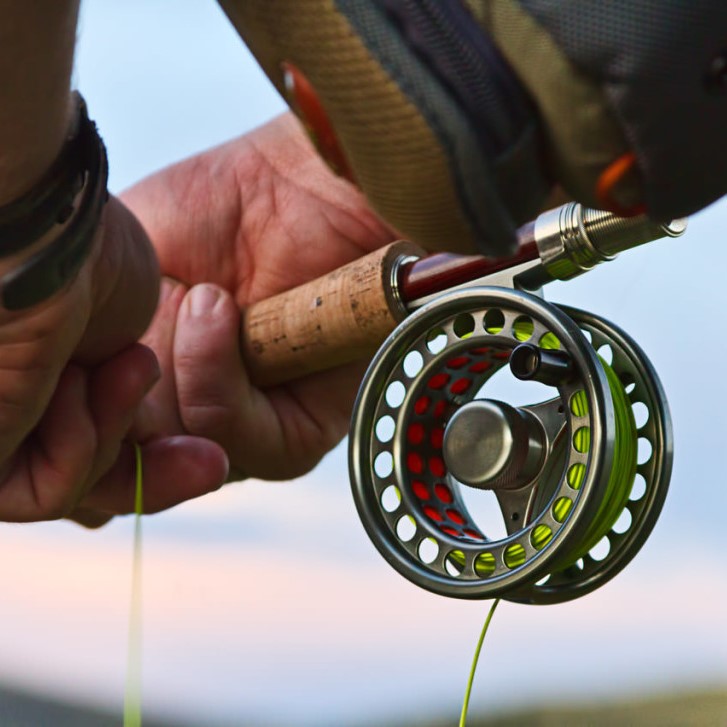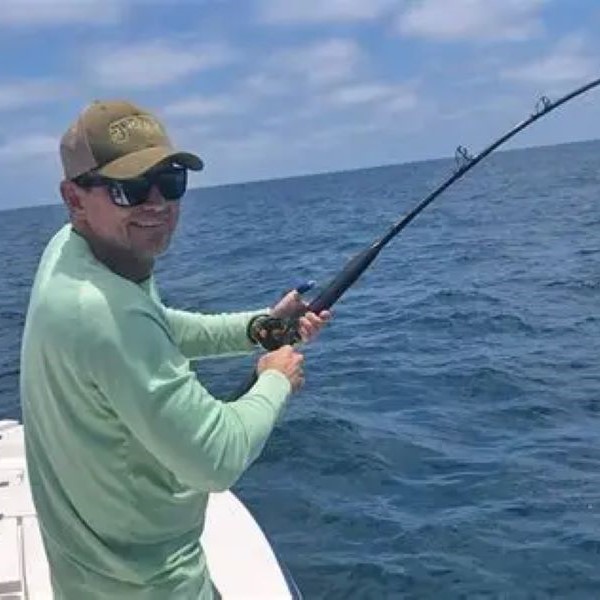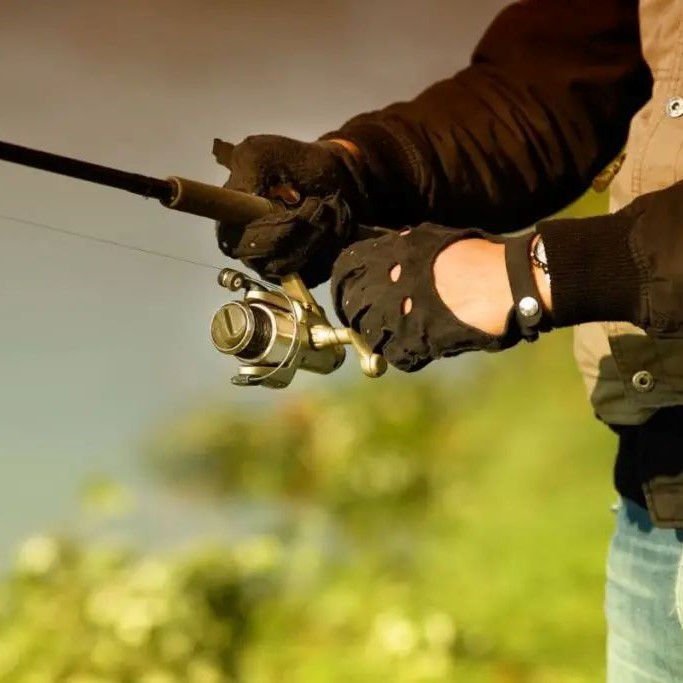Learning how to hold a fishing rod is one of the first steps every angler must master. It might seem simple at first glance. However, the way you grip your rod affects casting accuracy, sensitivity, and fatigue over time.
Moreover, proper technique enhances control and responsiveness. You’ll feel subtle bites more clearly. Your casts will fly farther and land more precisely.
Also, holding the rod correctly prevents strain. Long days on the water demand comfort. Poor grip can lead to hand cramps or wrist pain.
Many people overlook this basic skill. Yet, it forms the foundation of effective fishing. Mastering how to hold a fishing rod boosts confidence and results.
This guide covers everything from hand placement to casting posture. You’ll learn how to adapt your grip for various situations.
 Importance of Holding a Fishing Rod Correctly
Importance of Holding a Fishing Rod Correctly
Holding a fishing rod correctly is essential for a successful fishing experience. A proper grip can improve your casting distance and accuracy. It also helps reduce fatigue during long fishing sessions. Incorrect handling can lead to missed catches and unwanted strain.
Fishing rods are designed with specific balance points and features. Using the right grip ensures you fully utilize these design elements. It also prevents damage to the rod caused by improper handling.
An effective grip allows for better control over the rod. This control is crucial when reeling in fish, especially larger ones. It also decreases the risk of your rod slipping from your hand.
With a good grip, beginners can learn faster and enjoy fishing more effectively. For experienced anglers, mastering grip techniques enhances overall performance.
Whether you are fishing for leisure or sport, how you hold the rod matters. Spending time learning the correct grip can make all the difference in your fishing success.
Key Parts of a Fishing Rod to Grip
Understanding the key parts of a fishing rod is crucial for proper handling. Each section of the rod plays a role in grip effectiveness:
Handle
The handle is where you hold the fishing rod. It is usually covered in cork or foam for comfort. Gripping the handle firmly provides control while casting and reeling.
Reel Seat
The reel seat is where the fishing reel attaches to the rod. Ensure your hand partially covers the reel seat. This gives you stability during usage.
Butt
The butt is the bottom part of the rod. It can be used for leverage, especially when dealing with larger fish.
Blank
The blank is the main rod structure between the handle and the tip. Avoid gripping this section to maintain the rod’s balance.
Guides
Guides are the rings along the rod where the fishing line passes through. Never hold these, as it can affect performance and might damage the rod.
Knowing these parts helps you understand where to position your hands effectively. This knowledge is vital for beginners learning how to hold a fishing rod properly.
 Different Types of Fishing Rod Grips
Different Types of Fishing Rod Grips
Fishing rods are designed with different grip styles. Each style fits specific preferences and techniques. Understanding these grip types helps you choose the best option for your fishing needs. Here are the most common fishing rod grips:
Full Grip
The full grip extends along most of the handle. It provides comfort and control for two-handed casting. This grip is ideal for larger rods used in heavy fishing conditions. Materials like cork or EVA foam improve comfort during long use.
Split Grip
The split grip has gaps between sections of the handle. It reduces the overall weight of the rod. This design aids in balance and allows for better casting accuracy. Anglers often prefer split grips for finesse fishing techniques.
Pistol Grip
The pistol grip is short and shaped like a gun handle. It is commonly used on baitcasting rods. This grip style is perfect for one-handed casting and offers great control. However, it might not be suitable for handling larger fish.
Trigger Grip
The trigger grip includes a small hook-like feature for your index finger. It is an excellent choice for baitcasting or spinning reels. This grip provides added stability and control during reeling and casting. It reduces hand fatigue when fishing for long hours.
Rubber or Textured Grips
These grips feature non-slip materials like rubber or textured coatings. They improve grip, especially in wet or humid conditions. This type works well in many environments, ensuring your rod doesn’t slip.
Choosing the right grip impacts your performance and comfort. Assess your fishing style and target fish species. This ensures you get a grip design suited for your needs.
Step-by-Step Guide to Holding a Fishing Rod
Holding a fishing rod the right way ensures comfort and successful fishing. Follow these simple steps:
- Place Your Hand on the HandleGrip the handle firmly but not too tightly. Make sure your grip feels natural.
- Position Fingers Around the Reel SeatRest two or three fingers near the reel seat for added stability.
- Adjust Grip According to Rod TypeFor spinning rods, place your index finger near the rod’s blank for balance. On baitcasting rods, use the trigger grip for control.
- Check Your Thumb PlacementUse your thumb to control the top of the handle while casting or reeling.
- Hold the Rod at a Comfortable AngleTilt the rod slightly downward during casting. Keep your wrist relaxed but steady.
- Maintain a Balanced Grip While CastingBalance your grip to maximize accuracy and power during your cast.
- Use Both Hands for Larger FishGrip the butt of the rod with your free hand when fighting large fish.
Follow these steps to master how to hold a fishing rod effectively. Practice regularly for better control and technique.
 Common Mistakes to Avoid When Holding a Fishing Rod
Common Mistakes to Avoid When Holding a Fishing Rod
Mastering how to hold a fishing rod requires avoiding common mistakes. These missteps can hinder your performance and cause discomfort. Let’s look at the most frequent errors anglers make and how to avoid them.
Gripping the Rod Too Tightly
A tight grip may seem secure, but it causes hand fatigue over time. It also reduces flexibility, making casting and reeling harder. Hold the rod firmly but maintain a relaxed grip.
Holding the Rod Too Loosely
A loose grip risks the rod slipping. This is especially problematic when fighting a fish. Always ensure your grip is stable without over-relaxing.
Placing Hands Incorrectly
Placing your hands too far from the reel seat lowers control and balance. Ideally, position your hand around the handle, with fingers comfortably supporting the reel seat for stability.
Ignoring Reel Type While Gripping
Your technique should suit your reel type—spinning or baitcasting. Failing to adjust may impact casting precision. For spinning reels, rest fingers near the blank; for baitcasting, use a trigger grip.
Incorrect Thumb Placement
Your thumb plays a key role, especially in casting. Misplacing it reduces accuracy. Place your thumb along the top of the rod to enhance control.
Overlooking Rod Balance
Holding the rod in an unbalanced way leads to strain and poor handling. Ensure the weight is evenly distributed by gripping at the proper balance point.
Using One Hand Incorrectly for Large Fish
Anglers often struggle with big fish due to improper use of their free hand. For large catches, grip the butt with your other hand for extra leverage and strength.
Avoiding these mistakes helps you improve your fishing efficiency and enjoy more success. Regular practice and awareness make holding a fishing rod second nature.
Adjusting Your Grip Based on Fishing Techniques
Different fishing techniques require specific grip adjustments for optimal performance and comfort. Adapting your grip ensures better control and versatility in various scenarios. Below are common techniques and the corresponding grip adjustments:
Casting Techniques
- Overhead Casting
- Hold the rod’s handle with a relaxed grip.
- Place your thumb on top for better control.
- Use your dominant hand to guide the rod.
- Sidearm Casting
- Use a firm grip to maintain accuracy.
- Keep your wrist steady but flexible.
- Position your thumb alongside the handle.
- Roll Casting
- Hold near the reel seat for good balance.
- Use your free hand to support the rod’s butt.
- Maintain a smooth, fluid motion.
Jigging Techniques
- Vertical Jigging
- Grip closer to the reel seat for more control.
- Adjust your fingers for stability during quick movements.
- Support with your other hand for larger catches.
- Horizontal Jigging
- Hold the rod handle firmly but maintain flexibility.
- Place your thumb slightly forward for precision.
- Rotate the rod gently to mimic bait movement.
Trolling Techniques
- Light Trolling
- Use a balanced grip with your hand near the reel.
- Ensure your grip does not strain your wrist.
- Allow the rod to rest against your arm for support.
- Heavy Trolling
- Hold the rod farther back on the handle.
- Use your other hand to grip the butt.
- Adjust grip pressure based on drag tension.
Fly Fishing Techniques
- Standard Fly Casting
- Use a light grip to feel the line’s tension.
- Place your thumb flat on top for control.
- Balance the rod’s weight with both hands.
- Spey Casting
- Use two hands to hold the handle and butt.
- Your top hand should guide the rod’s direction.
- Your lower hand provides power for the cast.
Understanding these grip adjustments can enhance your technique and improve your fishing success. Tailor your grip to the technique for the best results.
 How Grip Affects Casting and Accuracy
How Grip Affects Casting and Accuracy
Your grip significantly impacts both casting distance and accuracy. A proper grip provides better control and stability. It ensures that your rod movements are precise and fluid during casts.
Improved Casting Distance
- Balanced Hold: A balanced grip lets you apply optimal power for longer casts.
- Thumb Placement: Placing your thumb correctly improves leverage when releasing the line.
- Hand Position: Gripping near the reel seat helps transfer force effectively for greater distance.
Enhanced Casting Accuracy
- Wrist Control: A relaxed grip ensures smoother motion and directional control.
- Thumb Alignment: Keeping your thumb aligned along the rod improves aim.
- Consistent Grip Pressure: Maintaining steady pressure prevents accidental line slips during casts.
Reduced Casting Errors
- Comfortable Grip: Avoiding strain ensures consistent and error-free casting.
- Non-Slip Grip: Using textured materials ensures the rod stays stable in your hand.
- Proper Finger Placement: Correct finger positioning avoids rod wobble.
Practicing these techniques enhances your ability to cast accurately over time. Adjusting grip based on your casting needs yields the best results.
Tips for Improving Your Grip Over Time
Improving your grip over time requires consistent practice and learning. A strong and effective grip boosts your control and confidence in handling the fishing rod. Here are practical tips:
Practice Regularly
- Hold your fishing rod often to build comfort and familiarity.
- Try different grip styles to find what suits your technique best.
- Test grips during various fishing tasks like casting, reeling, or fighting fish.
Strengthen Hand Muscles
- Use hand exercises to increase grip strength and endurance.
- Squeeze stress balls or use grip trainers to enhance finger and palm strength.
- Focus on building wrist flexibility to avoid strain during long fishing sessions.
Focus on Thumb Placement
- Check thumb positioning before every cast. Proper alignment improves control and reduces errors.
- Use the thumb as a guide along the handle for precision in casting.
Adapt to Weather Conditions
- Ensure your grip is secure in wet or cold weather. Non-slip materials help in these situations.
- Use gloves during extreme weather to maintain a stable hold.
Record and Review Your Progress
- Keep track of your grip adjustments and fishing success.
- Evaluate how changes in technique impact casting accuracy and rod control.
Learn from Other Anglers
- Watch experienced anglers and observe their grip techniques.
- Ask for advice to improve the way you hold the fishing rod.
Experiment with Different Rods
- Practice grip techniques on various rod types to expand your skills.
- Use lightweight rods for flexibility and heavier ones for strength and stability training.
Following these tips ensures steady improvement in your fishing grip over time. Regular practice along with focused adjustments helps you master essential techniques for fishing success.
Frequently Asked Questions About How to Hold a Fishing Rod
Should I always use one hand?
No. Use two hands when fighting large fish. One hand works for most casting and reeling.
Where should my index finger go?
On top of the rod, just above the reel. Helps control casting and feel bites.
Can I wear gloves while fishing?
Yes. Choose thin, flexible ones. Avoid bulky winter gloves for best sensitivity.
How tight should I grip the rod?
Lightly. Imagine holding a small bird. Firm enough to hold, gentle enough not to crush.
Do kids need special techniques?
Just smaller rods. Teach them the same basics. Adjust for their hand size.
Is there a universal grip for all rods?
No. Spinning, baitcasting, and fly rods all differ. Learn each style separately.
What if my hand gets tired?
Switch hands. Take breaks. Stretch your fingers and wrist periodically.
Should I hold the rod vertically or horizontally?
Depends on technique. Vertical for finesse, horizontal for casting and retrieving.
 Final Thoughts on Mastering How to Hold a Fishing Rod
Final Thoughts on Mastering How to Hold a Fishing Rod
Understanding how to hold a fishing rod transforms your fishing experience. It improves casting, sensitivity, and endurance.
From hand placement to safety, every detail adds up. Small adjustments lead to bigger catches.
Whether you’re a beginner or refining your skills, focus on fundamentals. Technique matters more than gear.
Practice regularly. Dry runs build muscle memory. Confidence grows with repetition.
Now you know the essentials. Apply them on your next trip. Feel the difference in control and comfort.
Let your rod become an extension of your body. With time, holding it will feel natural.
Remember, mastering how to hold a fishing rod is the first step to becoming a better angler.